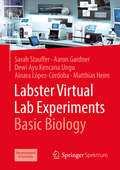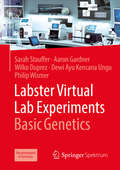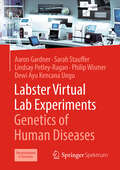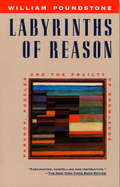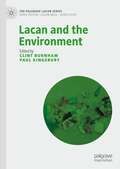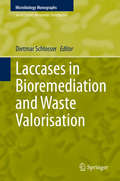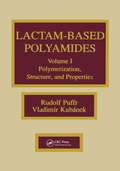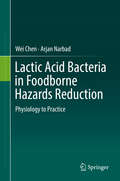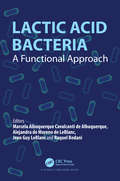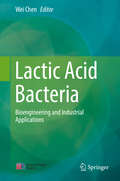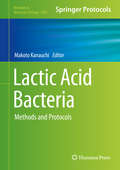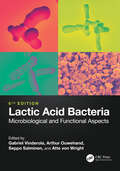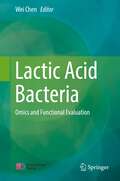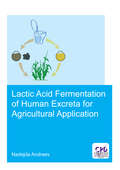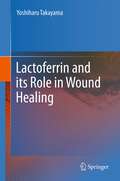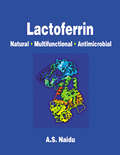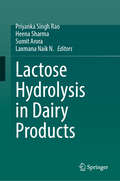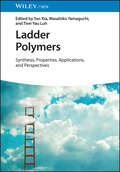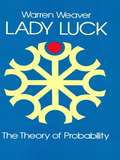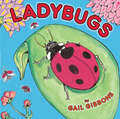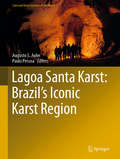- Table View
- List View
Labster Virtual Lab Experiments: Basic Biology
by Matthias Heim Sarah Stauffer Aaron Gardner Dewi Ayu Ungu Ainara López-CórdobaThis textbook helps you to prepare for both your next exams and practical courses by combining theory with virtual lab simulations. With the “Labster Virtual Lab Experiments” book series you have the unique opportunity to apply your newly acquired knowledge in an interactive learning game that simulates common laboratory experiments. Try out different techniques and work with machines that you otherwise wouldn’t have access to.In this volume on “Basic Biology” you will learn how to work in a biological laboratory and the fundamental theoretical concepts of the following topics: Lab SafetyMitosisMeiosisCellular RespirationProtein SynthesisIn each chapter, you will be introduced to the basic knowledge as well as one virtual lab simulation with a true-to-life challenge. Following a theory section, you will be able to play the corresponding simulation. Each simulation includes quiz questions to reinforce your understanding of the covered topics. 3D animations will show you molecular processes not otherwise visible to the human eye.If you have purchased a printed copy of this book, you get free access to five simulations for the duration of six months. If you’re using the e-book version, you can sign up and buy access to the simulations at www.labster.com/springer.If you like this book, try out other topics in this series, including “Basic Genetcis”, “Basic Biochemistry”, and “Genetics of Human Diseases”.
Labster Virtual Lab Experiments: Basic Genetics
by Sarah Stauffer Aaron Gardner Dewi Ayu Ungu Wilko Duprez Philip WismerThis textbook helps you to prepare for both your next exams and practical courses by combining theory with virtual lab simulations. With the “Labster Virtual Lab Experiments” book series you have the unique opportunity to apply your newly acquired knowledge in an interactive learning game that simulates common laboratory experiments. Try out different techniques and work with machines that you otherwise wouldn’t have access to.In this volume on “Basic Genetics” you will learn how to work in a laboratory with genetic background and the fundamental theoretical concepts of the following topics:Mendelian InheritancePolymerase Chain ReactionAnimal GeneticsGene ExpressionGene RegulationIn each chapter, you will be introduced to the basic knowledge as well as one virtual lab simulation with a true-to-life challenge. Following a theory section, you will be able to play the corresponding simulation. Each simulation includes quiz questions to reinforce your understanding of the covered topics. 3D animations will show you molecular processes not otherwise visible to the human eye. If you have purchased a printed copy of this book, you get free access to five simulations for the duration of six months. If you’re using the e-book version, you can sign up and buy access to the simulations at www.labster.com/springer.If you like this book, try out other topics in this series, including “Basic Biology”, “Basic Biochemistry”, and “Genetics of Human Diseases”.
Labster Virtual Lab Experiments: Genetics of Human Diseases
by Sarah Stauffer Aaron Gardner Philip Wismer Lindsay Petley-Ragan Dewi Ayu Kencana UnguThis textbook helps you to prepare for your next exams and practical courses by combining theory with virtual lab simulations. The “Labster Virtual Lab Experiments” series gives you a unique opportunity to apply your newly acquired knowledge in a learning game that simulates exciting laboratory experiments. Try out different techniques and work with machines that you otherwise wouldn’t have access to. <p><p> In this book, you’ll learn the fundamental concepts of the genetics of human diseases focusing on: <p> Monogenic Disorders - Cytogenetics - Medical Genetics - Viral Gene Therapy
Labyrinths of Reason: Paradox, Puzzles, and the Frailty of Knowledge
by William PoundstoneThis sharply intelligent, consistently provocative book takes the reader on an astonishing, thought-provoking voyage into the realm of delightful uncertainty--a world of paradox in which logical argument leads to contradiction and common sense is seemingly rendered irrelevant. (From the Trade Paperback edition.)
Lacan and the Environment (The Palgrave Lacan Series)
by Clint Burnham Paul KingsburyIn this exciting new collection, leading and emerging Lacanian scholars seek to understand what psychoanalysis brings to debates about the environment and the climate crisis. They argue that we cannot understand climate change and all of its multifarious ramifications without first understanding how our terrifying proximity to the real undergirds our relation to the environment, how we mistake lack for loss and mourning for melancholy, and how we seek to destroy the same world we seek to protect. The book traces Lacan’s contribution through a consideration of topics including doomsday preppers, forest suicides, Indigenous resistance, post-apocalyptic films, the mathematics of climate science, and the relevance of Kant. They ask: What can you do if your neighbour is a climate change denier? What would Bartleby do? Does the animal desire? Who is cleaning up all the garbage on the internet? Why is the sudden greening of the planet under COVID-19 no help whatsoever? It offers a timely intervention into Lacanian theory, environmental studies, geography, philosophy, and literary studies that illustrates the relevance of psychoanalysis to current social and environmental concerns.
Laccases in Bioremediation and Waste Valorisation (Microbiology Monographs #33)
by Dietmar SchlosserThis Microbiology Monographs volume covers the latest advances in laccase applications in bioremediation and waste valorisation. The first three chapters provide a comprehensive introduction to fungal and bacterial laccases (the two most important enzyme groups from an application viewpoint) and their practical use in bioremediation and lignocellulosic waste valorisation. Subsequent chapters discuss possible combinations of laccases and further potentially collaborating enzymes, and offer in-depth insights into laccase immobilisation for wastewater treatment and environmental biosensor applications of laccases. Lastly, the book addresses the quest for enzymes with improved and better-fitting properties, covering laccase engineering by directed and computational evolution, and novel enzymes from extreme environments. As such, it is a fascinating read for microbiologists in both industry and academia.
Lactam-based Polyamides, Volume I: Polymerization Structure
by Rudolf Puffr Vladimir KubanekThis two-volume work examines general relationships among the structures, reactivity, and properties of polyamides important for predictions in such fields as materials science. The team of authors, including polymer research chemists, physicists, and specialists in technology and processing, compiled an extensive amount of literature (over 2300 references) to produce two volumes packed with text, tables, drawings, and first-hand information, much of it never before published. Topics include lactams and their production, properties, analysis, theory, and the technology of their polymerization, in addition to polyamides and their processing, modification, analysis, molecular characterization, structure, physical properties, degradation and stabilization, designing and application of products. Researchers and specialists in the preparation, modification, processing, structure, and properties of linear aliphatic polyamides will find Lactam-Based Polyamides, Volumes I and II to be invaluable texts.
Lactic Acid Bacteria in Foodborne Hazards Reduction: Physiology to Practice
by Wei Chen Arjan NarbadThis book provides an overview of the physiological basis of lactic acid bacteria and their applications in minimizing foodborne risks, such as pathogens, heavy metal pollution, biotoxin contamination and food‐based allergies. While highlighting the mechanisms responsible for these biological effects, it also addresses the challenges and opportunities that lactic acid bacteria represent in food safety management. It offers a valuable resource for researchers, graduate students, nutritionists and product developers in the fields of food science and microbiology.
Lactic Acid Bacteria: A Functional Approach
by Alejandra de Moreno de LeBlancLactic acid bacteria (LAB) are a diverse group of bacteria that comprise low GC content Gram-positive cocci or rods that produces lactic acid as the major end product of the fermentation process. Bifidobacterium genera may also be considered as a part of the LAB group for possessing some similar phenotypical characteristics despite the higher GC content. The key feature of LAB metabolism is efficient carbohydrate fermentation. This contributes to the production of several microbial metabolites that result in the improvement of flavor and texture of fermented foods, in addition to its positive impact on the human health when LAB is administered as a probiotic. The book deals with advances made in the functionalities of LAB, such as their effect on vitamin D receptor expression, impact on neurodegenerative pathologies, production of B-vitamins for food bio-enrichment, production of bacteriocins to improve gut microbiota dysbiosis, production of metabolites from polyphenols and their effects on human health, effect on reducing the immunoreaction of food allergens, as biological system using time-temperature to improve food safety, and the use of probiotics in animal feed. The book also reviews the use of LAB and probiotic technologies to develop new functional foods and functional pharmaceuticals.
Lactic Acid Bacteria: Bioengineering and Industrial Applications
by Wei ChenThis book introduces readers to basic studies on and applied techniques involving lactic acid bacteria, including their bioengineering and industrial applications. It summarizes recent biotechnological advances in lactic acid bacteria for food and health, and provides detailed information on the applications of these bacteria in fermented foods. Accordingly, it offers a valuable resource for researchers and graduate students in the fields of food microbiology, bioengineering, fermentation engineering, food science, nutrition and health.
Lactic Acid Bacteria: Methods and Protocols (Methods in Molecular Biology #1887)
by Makoto KanauchiThis detailed book provides a collection of protocols for numerous experimental approaches perfected by the authors for lactic acid bacteria (LAB) research. Split in to three parts, the volume delves into the identification and metabolism of LABs, the applications of the bacteria for the food industry, as well as healthy functions of LAB. Written for the highly successful Methods in Molecular Biology series, chapters include introduction to their respective topics, lists of the necessary materials and reagents, step-by-step, readily reproducible laboratory protocols, and tips on troubleshooting and avoiding known pitfalls. Authoritative and accessible, Lactic Acid Bacteria: Methods and Protocols serves as an ideal inspiration for many research efforts in the domains of food science and health science.
Lactic Acid Bacteria: Methods and Protocols (Methods in Molecular Biology #2851)
by Makoto KanauchiThis updated volume presents experimentation-based approaches to lactic acid bacteria (LAB) research. Split into three parts, the book explores techniques for analyzing lactic acid bacteria metabolism and characteristics, applications for food-related industries, such as yogurt production, beer, and wine making, and functions of LAB in human health. Written for the highly successful Methods in Molecular Biology series, chapters include introduction to their respective topic, lists of the necessary materials and reagents, step-by-step and readily reproducible laboratory protocols, and tips on troubleshooting and avoiding known pitfalls. Authoritative and up-to-date, Lactic Acid Bacteria: Methods and Protocols, Second Edition serves as an ideal guide for improving research into this vital area of nutrition and health science.
Lactic Acid Bacteria: Microbiological and Functional Aspects
by Seppo Salminen Atte Von Wright Gabriel Vinderola Arthur C. OuwehandThrough five editions, and since 1993, Lactic Acid Bacteria: Microbiological and Functional Aspects has provided readers with information on how and why fermentation by lactic acid-producing bacteria improves the shelf life, palatability, and nutritive value of perishable foods and also how these microbes have been used as probiotics for decades. Thoroughly updated (with the current lactobacilli taxonomy) and fully revised, with a rearrangement of chapters into four sections, the Sixth Edition covers new findings on health effects, properties, production and stability of LAB as well as regulatory aspects globally. The new edition also addresses the technological use of LAB in various fermentations of food, feed, and beverage and their safety considerations. It also includes the rising concept of postbiotics and discusses new targets such as cognitive function, metabolic health, and respiratory health.Key Features: In 42 chapters, divided into 4 sections, findings are presented on health effects, properties and stability of LAB as well as production of target-specific LAB. Covers the revised ‘Lactobacillus’ taxonomy Addresses novel topics such as postbiotics Presents new discoveries related to the mechanisms of actions of lactic acid bacteria Covers the benefits of LAB in fermentation of dairy, cereal, meat, vegetable and silage, including non-Western traditional fermented foods from Africa and Asia Discusses the less-known role of LAB as food spoilers Reports on the health benefits of LAB on humans and animals Covers the global regulatory framework related to safety and efficacy
Lactic Acid Bacteria: Omics and Functional Evaluation
by Wei ChenThis book discusses the latest research and new techniques in the field of lactic acid bacteria, including comparative genomics, transcriptomics, proteomics and metabolomics. It also introduces the omics and functional evaluation in detail and shows the links between lactic acid bacteria and gut health and host immunity. Summarizing the biotechnological advances in lactic acid bacteria for food and health, it is a valuable resource for researchers and graduate students in the fields of food microbiology, bioengineering, food science, nutrition and health.
Lactic acid fermentation of human excreta for agricultural application (IHE Delft PhD Thesis Series)
by Nadejda AndreevHuman excreta is a valuable fertilizer for improving soil quality and crop productivity, with a potential to replace or complement the mineral fertilizers. The main challenges related to human excreta regarding agricultural applications are microbial contamination risks, loss of nutrients, and odor issues. Fertilization by lacto-fermented faeces supplemented by biochar has benefits such as improved soil bulk density, nitrate and potassium concentrations as well as the yield and yield components of corn, compared to untreated, simple stored faeces, urine, cattle manure, and unfertilized controls. Even though the mineral fertilizer produced corn with significantly higher height and leaf length, it did not add significantly higher yields than lacto-fermented faeces supplemented by biochar. A faeces treatment process by combined lacto-fermentation with thermophilic composting and biochar supplementation had better reduction of coliforms, Escherichia coli, Enterococcus faecalis and Clostridium perfringens, and higher germination of radish and growth of tomatoes than combined lacto-fermentation with vermicomposting. Urine lacto-fermentation contributed to a pH reduction below 4, a decrease in the ammonium concentration and odor strength, as well as an increase in the germination rates compared to untreated stored urine. The results of this study provide important information that can set the basis for scaling up a sustainable technology for the treatment of source separated human excreta while improving its potential for resource recovery.
Lactoferrin and its Role in Wound Healing
by Yoshiharu TakayamaLactoferrin is an iron-binding glycoprotein belonging to the transferrin family. It acts as a defense in host animals against microbes and viruses, since it has a broad spectrum of antimicrobial and antiviral activities. Lactoferrin has been shown to regulate the growth and differentiation of many types of cells. The results of recent studies indicate that lactoferrin is a potent regulator of dermal fibroblasts, and promotes cutaneous wound healing. The collagen gel contraction, a model of wound contraction during wound healing process, and migration of human fibroblasts were enhanced by lactoferrin. LRP-1 (LDL Receptor related Protein-1) acts as a signaling receptor for lactoferrin that mediate fibroblast response to lactoferrin by activating ERK/MAPK signaling pathway. In addition, lactoferrin promotes biosynthesis of extracellular matrix (ECM) component such as type-I collagen and hyaluronan. Hyaluronan is a major component of ECM in connective tissue and promotes wound healing. The promoting effect of lactoferrin on hyaluronan production was accompanied by promotion of HAS2 (hyaluronan synthase 2) expression. These observations suggest that lactoferrin promotes the wound healing by providing an ECM that promotes fibroblast migration. Lactoferrin is also known for its anti-inflammatory and immune modulating properties. According to recent in vivo study, lactoferrin promotes wound repair by promoting the early inflammatory phase of wound healing. Based on this, recombinant human lactoferrin was subsequently tested clinically in a Phase II trial in patients with diabetic ulcers and was found to be effective. Lactoferrin should be further evaluated in patients with diabetic and other types of ulcers.
Lactoferrin: Natural - Multifunctional - Antimicrobial
by Narian NaiduRecently, researchers found that lactoferrin, when activated, functions as a potent antimicrobial intervention. It protects food by removing harmful bacteria from the surface and by starving bacteria before they can multiply and produce harmful toxins; it also prevents bacteria from re-attaching to food surfaces. As a result this substance has potential to help the agribusiness and food industry supply safer food products to consumers. Lactoferrin: Natural - Multifunctional - Antimicrobial details microbial blocking technology to protect foods from harmful microbes and presents the scientific background on use of this naturally occurring microbial blocking agent as an effective food antimicrobial intervention.
Lactose Hydrolysis in Dairy Products
by Priyanka Singh Rao Heena Sharma Sumit Arora Laxmana Naik N.Lactose is the major disaccharide present in milk. Metabolism of lactose requires lactase which is present in the brush border of epithelial cells of the small intestine. Deficiency of this enzyme leads to malabsorption of lactose and fermentation of lactose occurs in gut which results in various gastrointestinal disorders. Around 70% of the world population suffers from lactose intolerance. Such individuals face difficulty in consumption of milk and milk products. This has led to a great demand in market for the milk products which are either low in lactose or lactose free. Major advances have been made in the production of lactose-free dairy products through lactose hydrolysis processing methods. Most of the books available on lactose hydrolysis in dairy products were published from 1970-1990. Awareness on lactose intolerance has increased in past one decade and development of new strategies to address this issue are progressing at rapid rate. There is a great need for consolidated information representing all aspects of lactose hydrolyzed dairy products. Lactose Hydrolysis in Dairy Products addresses the significance and application of lactose hydrolyzed products from production to consumption. It mainly emphasizes the basic principles that are essential to understand the concept of lactose intolerance and the various processes utilized for production of lactose-free dairy foods. Methods such as enzymatic hydrolysis, membrane processing and fermentation are covered in full. Further coverage includes alternative approaches to combat lactose intolerance, conversion of lactose to other bioactive derivatives and their health effects and the regulatory aspects and the main challenges and potential solutions for the production of lactose hydrolyzed products.
Ladder Polymers: Synthesis, Properties, Applications and Perspectives
by Yan Xia Masahiko Yamaguchi Tien-Yau LuhLadder Polymers An essential reference covering the latest research on ladder polymers Ladder polymers are a unique macromolecular architecture, consisting of a continuous strand of fused rings in their backbones. Such distinctive structures lead to a range of interesting thermal, optical, and electronic properties and self-assembly behaviors, which have been explored for various applications. The book Ladder Polymers: Synthesis, Properties, Applications, and Perspectives presents a collection of diverse topics in ladder polymers consisting of historical overview, state-of-the-art research and development, and potential future directions, written by leading researchers in the related fields. The topics include: Conjugated ladder polymers and graphene nanoribbons Nonconjugated microporous ladder polymers or polymers of intrinsic microporosity Covalent double-stranded polymersSupramolecular double-helical polymers and oligomers Two dimensional polymers This book is a one-stop resource on all the critical research developments in the subject of ladder polymers for broad readership including organic, polymer, and physical chemists, materials scientists and engineers, and chemical engineers.
Lady Luck: The Theory of Probability
by Warren Weaver"Should I take my umbrella?" "Should I buy insurance?" "Which horse should I bet on?" Every day - in business, in love affairs, in forecasting the weather or the stock market questions arise which cannot be answered by a simple "yes" or "no." Many of these questions involve probability. Probabilistic thinking is as crucially important in ordinary affairs as it is in the most abstruse realms of science. This book is the best nontechnical introduction to probability ever written. Its author, the late Dr. Warren Weaver, was a professor of mathematics, active in the Rockefeller and Sloan foundations , an authority on communications and probability, and distinguished for his work at bridging the gap between science and the average citizen. In accessible language and drawing upon the widely diverse writings of thinkers like Kurt Godel, Susanne K.Langer, and Nicholas Bernoulli, Dr. Weaver explains such concepts as permutations, independent events, mathematical expectation, the law of averages, Chebychev's theorem, the law of large numbers, and probability distributions. He uses a probabilistic viewpoint to illuminate such matters as rare events and coincidences, and also devotes space to the relations of probability and statistics, gambling, and modern scientific research. Dr. Weaver writes with wit, charm and exceptional clarity. His mathematics is elementary, grasp of the subject profound, and examples fascinating. They are complemented by 49 delightful drawings by Peg Hosford. 13 tables. 49 drawings. Foreword. Index.
Lady's Knight
by Amie Kaufman Meagan SpoonerAn undeniably fierce, unforgettably funny, unapologetically queer feminist romp through the England of medieval legend. Bestselling and acclaimed authors Amie Kaufman and Meagan Spooner bring readers along on an epic quest for valor, freedom, and, above all, love. A Knight’s Tale meets the Lady Jane series, with a dash of The Great!Gwen is sick of hiding—hiding the fact that she’s taken over her father’s blacksmithing duties, hiding her attraction to girls, hiding her yearning for glory as a knight.Meanwhile, Lady Isobelle of Avington, queen bee of the castle, has never once considered hiding who she is—until now. She’s been chosen as the grand prize in the Tournament of Dragonslayers, to be given to whichever knight can claim her hand. And for the first time in her life, she can’t talk her way out of trouble.When Isobelle discovers Gwen’s knightly ambitions, they hatch a scheme together—Gwen will joust in the tournament, disguised as Sir Gawain. Winning means freedom for Isobelle, and glory for Gwen. Losing means… well, let’s not go there.One thing’s for sure: Falling in love was never the plan.But the best laid plans…are often trampled all over by dragons."A sapphic delight, full of jousts, jaunts, and courtly love. Lady's Knight sparkles with wit and charm and has lady knights to swoon over. Kaufman and Spooner will leave you breathless." —C. S. Pacat, New York Times bestselling author of Dark Rise“Kaufman and Spooner are auto-buy authors for me, always guaranteed to get my heart pumping with their page-turning romance and high-stakes adventure.” —New York Times bestselling author Susan Dennard"There are a lot of damsels in Lady's Knight, but none of them need a man to fix their problems. (Men seem to be the source of the problems, in fact.) Wholesome, heartfelt, and more fun than cheesecake on a stick, Kaufman and Spooner's latest book is all about women's work. You know, jousting, dragonslaying, and saving the kingdom—all while looking fabulous." —Jodi Meadows, coauthor of the New York Times bestselling novels My Lady Jane and My Plain Jane“Clever, funny, thrilling, and romantic—Lady’s Knight will inspire readers to take up their swords to fight dragons and the patriarchy. Perfect for fans of A Knight’s Tale and anyone who loves a romantasy with wit, charm, and the occasional comedic fourth wall break.” —F. T. Lukens, New York Times bestselling author of So This Is Ever After"You'll laugh, you'll cry, and you'll be ready to fight any dragon after reading this delightful tale full of swoony romance, heart-racing action, and the very best banter in the realm!" —Beth Revis, New York Times bestselling coauthor of Night of the Witch"Writing that is above all else marvelously warm and at the same time witty, adventure and romance that will sweep you off your feet—a double sweep, and a triumph!" —Sarah Rees Brennan, #1 Sunday Times bestselling author of Long Live Evil"Sparkles with wit and romance! So many quotable lines. Not to mention the sexiest gown-lacing scene in modern literature. Like its characters, Lady's Knight is endlessly clever and resourceful." —Ellen Kushner, award-winning author of Swordspoint
Ladybug Life Cycle
by Justin Mccory MartinLearn how ladybugs grow from tiny eggs into shiny, colorful insects in this Science Vocabulary Reader. This book is part of a series of books for early readers about the life cycles of different animals.
Ladybugs
by Gail GibbonsEverything you ever wanted to know about ladybugs— and why they're crucial to our environment. When you think of a ladybug, you might picture a little red beetle with seven black spots on its back—but did you know there are thousands of types of ladybugs, spread across the world? With her signature combination of simple text, clear illustrations, and simple diagrams, Gail Gibbons explores the world of ladybugs. These small beetles live on six of the seven continents, ranging in size, markings, and coloration. Follow a ladybug through the four stages of its development from egg to adult, and learn about its behavior and habitat—plus, how little ladybugs help protect crops by eating harmful insects. Bright illustrations and an easy-to-read text make this ideal for young readers studying the natural world. A page of quick ladybug facts and resources for learning more are included.
Ladybugs
by Monica HughesThis book identifies the main physical features of bug including what they eat, how they change, and how they reproduce.
Lagoa Santa Karst: Brazil's Iconic Karst Region (Cave and Karst Systems of the World)
by Augusto S. Auler Paulo PessoaThis book discusses the Lagoa Santa Karst, which has been internationally known since the pioneering studies of the Danish naturalist Peter Lund in the early 1800s. It covers the speleogenesis, geology, vegetation, fauna, hydrogeology, geomorphology, and anthropogenic use of the Lagoa Santa Karst and is the first English-language book on this major karst area. The area, which has been at the heart of the debate on the origin and age of human colonization in the Americas, is characterized by a classical and scenic karst landscape with limestone cliffs, karst lakes and karst plains, in addition to numerous solution dolines. More than 1,000 caves have been documented in the area, many with significant archeological and paleontological value. Despite its great importance, the Lagoa Santa Karst faces severe environmental threats due to limestone mining and the expansion of the metropolis of Belo Horizonte and its surrounding towns. The growing recognition of the area’s remarkable significance has led to increasing concern, and a number of protected areas have now been established, improving the conservation status of this landmark karst area.
